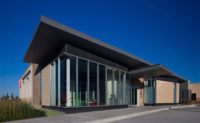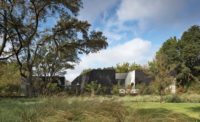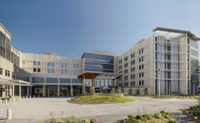What will the future of American medical care look like? One answer to that question lies amid the suburban sprawl of Allen, Texas, a bedroom community sprouting from the tawny prairie land some 30 miles north of downtown Dallas. There, on a stretch of nondescript parkway lined with banal strip malls and cookie-cutter housing developments, you will find an unexpectedly antic structure of folded zinc planes, jutting angles, and perforated mesh screens.
This interloper is Legacy ER, an 8,500-square-foot freestanding emergency room and urgent-care facility owned and operated by a group of local physicians. The architect is Yen Ong, a partner in 5G Studio Collaborative, a nine-year-old Dallas-based practice, which gained prominence in 2011 with its design for the 1,000-room Dallas Omni Hotel, a sleek wedge wrapped with bands of LED lighting.
Additional Content:
Jump to credits & specifications
The Allen facility is the second clinic owned and operated by the Legacy ER group and is one of a rapidly growing number of freestanding emergency care centers (FECCs) presenting a speedier alternative to increasingly pressed hospital emergency departments.
Texas leads in this type of independent clinic, according to the American College of Emergency Physicians, largely due to supportive state laws and an entrepreneurial climate. Yet FECCs are almost always located in affluent areas with lower Medicaid and Medicare populations, because they are not recognized for reimbursement by those services. Since the clinics generally don't serve underprivileged communities and can charge hefty facility fees, the rise of FECCs has generated concern in the medical profession.
But for physicians frustrated with the various indignities of hospital-based emergency-care practice, FECCs suggest a progressive alternative. Architecturally, Legacy ER's Allen clinic stands out among the generic “doc-in-a-box” types, both as a model of enlightened aesthetics and for its commitment to evidence based design (EBD), where empirical research applied throughout the design process enhances efficiency, safety, and patient experience. In the facility's exam rooms, for instance, beds and plumbing are aligned so patients can always be approached from the same side (the left), to reduce mistakes born of constant reorientation.
Ong embraced this philosophy during the planning of an earlier clinic for the Legacy ER partners in nearby Frisco in 2008. He felt constrained there by the turnkey developers' wishes, but in Allen, the doctors contracted directly with 5G, giving Ong free aesthetic rein.
“Modern was part of the ticket,” says Jay Woody, one of Legacy ER's founding partners. “If you're having a heart attack, you want to have a facility with the latest technology. If you see a building that's dingy and dull, you wonder if the doctors' medical knowledge is up to date.”
The steel-framed structure and its landscaped parking lot are oriented for maximum visibility from the road. For all its folded dynamism, in plan it is a rectangular box containing two rooms for trauma, six for emergency exams, and five for urgent care, along with spaces for X-ray and CT-scan imaging, a laboratory, and various support functions. Its 11 beds can accommodate well over 100 patients in a day, served by an on-site staff of around 15.
The facility's bifurcated program explains the disposition of spaces: on one side they are dedicated to emergency medicine; and on the other, to less critical urgent care. The compact plan, a product of Ong's application of EBD, is a direct response to the demand for efficiency. “In medical practice, a few seconds count a lot,” says Ong. The nursing station, with its panoptic orientation, acts as the brain of the clinical zone, allowing the medical staff and the patients to interact.
Also important in EBD is ample natural light. Here windows are included in exam rooms and at the ends of corridors, with skylights tucked into folded ceiling planes. “All that light makes it a nice place to work,” says Woody, “and helps the healing process.” The doctors have also found that the clinic's orthogonal geometry has a subconscious calming effect, making things seem neater than they are in reality.
When not tending patients, Woody and his partners can repair to a second-story conference room inserted under the folded zinc roof planes, reached by a steel stair and catwalk and shielded from the harsh Texas sun by the external perforated zinc screen. A small bedroom with adjacent bath is also provided for physicians on overnight call.
For both physicians and patients, the design represents a considerable improvement over the status quo. The typology, moreover, has the capacity to significantly improve access to care, if various regulatory issues are satisfied. As these facilities continue to proliferate, Legacy ER is a welcome example that other freestanding clinics might do well to follow.
CreditsArchitect: 5G Studio Collaborative Personnel in architect's firm who should receive special credit: Yen Ong, AIA, NCARB, LEED AP BD+C
Interior designer: 5G Studio Collaborative
Engineers: Structural: Datum Engineers, Inc Civil: RLK Engineering, Inc. MEP: Jordan & Skala Engineers, Inc. Consultant(s): Landscape: Smr Landscape Architects
General contractor: UEB Builders
Photographer(s): Michael Moran
Size: 8,500 square feet
Construction cost: $3.6 million
Project cost: $4.9 million
Completion date: November 2013 |
SpecificationsStructural system Steel
Exterior cladding Portland Cement Plaster: Metal Panels: Metal/glass curtain wall: Moisture barrier: Curtain wall:
Roofing TPO roofing: Metal:
Windows Metal frame:
Glazing Glass: Skylights:
Doors Automatic Door Entrances: Metal doors: Wood doors: Sliding doors: Special doors:
Hardware Locksets: Closers: Pulls: Security devices:
Interior finishes Suspension grid: Paints and stains: Plastic laminate: Solid surfacing: Floor and wall tile: Resilient flooring: Carpet:
Furnishings Office furniture: Reception furniture: Chairs: Tables: Bedroom:
Lighting Interior ambient lighting: Downlights: Exterior: Exterior Paver Light:
Plumbing Kohler |













Post a comment to this article
Report Abusive Comment